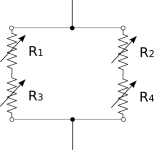hi all
I have a 20 foot nitrogen freezing tunnel that i have to do a new control system for.
The tunnel has one electric to pneumatic control valve 4-20 input for the whole tunnel. To have the temperature of the tunnel accurate i need to use two rtd PT100 probes one at the infeed and one at the exit of the tunnel. Using one temp. controller
PROBLEM: Has any one used or know of a device that can collect resistance from both probes and output a avrage resistance. I also looked for a dual input temperature controller but was not able to find anythig of that type.
Thanks for all yor help.
I have a 20 foot nitrogen freezing tunnel that i have to do a new control system for.
The tunnel has one electric to pneumatic control valve 4-20 input for the whole tunnel. To have the temperature of the tunnel accurate i need to use two rtd PT100 probes one at the infeed and one at the exit of the tunnel. Using one temp. controller
PROBLEM: Has any one used or know of a device that can collect resistance from both probes and output a avrage resistance. I also looked for a dual input temperature controller but was not able to find anythig of that type.
Thanks for all yor help.
Last edited:





